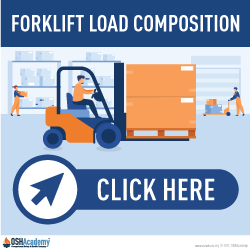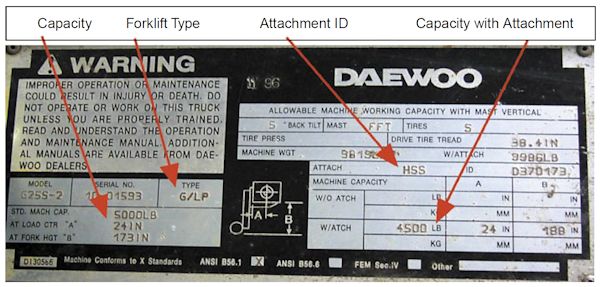Load Composition
The stated capacity of a forklift only applies to the load center indicated on the data plate.
As the image illustrates, if the load is not centered at the specified position, the forklift's capacity will be reduced.
The load size, position, and weight distribution critically affect the forklift's capacity and stability. Consider the following factors before engaging a load:
- Weight, Size, and Position
- Safe Load Capacity
- Maximum Load Moment
- Balance
- Stability
Weight, Size, and Position
Load weight, weight distribution, size, shape, and position are key factors affecting the stability of the forklift.
Forklifts are designed to carry a capacity load at a standard load center, commonly 24 inches. This means that the forklift’s capacity was determined as if the load were a cube whose weight is evenly distributed (i.e., whose center of gravity is exactly in the center of the cube) and which is resting on a standard pallet having dimensions of 48 inches by 48 inches.
With such a load, the horizontal distance from the center of the load to the vertical part of the forks would be 24 inches. Of course, most loads are not perfectly shaped cubes having their center of gravity exactly in the middle of the cube. To the extent that the load differs from this theoretical load — such as if it is irregularly shaped, has unbalanced weight distribution, or is not centered on the forks — the capacity may be reduced.
Capacity Plates
Forklifts have a capacity data plate to tell the user what loads are safe to lift.
The data plate will indicate the maximum lifting capacity of the machine to the full extension height of the mast and a specified load center for a given configuration.
- If the plate says the capacity is 30,000 pounds or less, then that capacity is rated for a load with a center of gravity 24 inches from the face of the forks.
- If the forklift capacity is greater than 30,000 pounds then the label will rate the load at a 36" or 48" center of gravity since larger forklifts usually lift physically larger loads.
Knowledge Check Choose the best answer for the question.
3-4. Where will you find information that tells you what loads your specific forklift may safely lift?
You forgot to answer the question!


